| Kedarnath Temple | |
|---|---|
| Kedarnath Jyotirlinga | |
 Kedarnath Temple Kedarnath Temple | |
| Religion | |
| Affiliation | Hinduism |
| District | Rudraprayag |
| Deity | Shiva |
| Festivals | Maha Shivaratri |
| Governing body | Shri Badarinath Kedarnath Temple Committee |
| Location | |
| Location | Kedarnath |
| State | Uttarakhand |
| Country | |
 | |
| Geographic coordinates | 30°44′6.7″N 79°4′0.9″E / 30.735194°N 79.066917°E / 30.735194; 79.066917 |
| Architecture | |
| Type | North-Indian Himalayan Architecture |
| Creator | Pandavas |
| Elevation | 3,583 m (11,755 ft) |
| Website | |
| badrinath-kedarnath | |
| Part of a series on |
| Shaivism |
|---|
 |
|
DeitiesParameshvara (Supreme being) |
| Scriptures and texts |
Philosophy
|
| Practices |
Schools
Saiddhantika Non - Saiddhantika
|
| Scholars |
| Related |
|
|
 Yamunotri
Yamunotri Gangotri
Gangotri Kedarnath
Kedarnath BadrinathThis box:
BadrinathThis box:
Kedarnath Temple (Sanskrit: केदारनाथ मंदिर, IAST: Kēdāranātha Mandira, lit. 'temple of the God of the field') is a Hindu temple, one of the twelve jyotirlinga of Shiva. The temple is located on the Garhwal Himalayan range near the Mandakini river, in the state of Uttarakhand, India. Due to extreme weather conditions, the temple is open to the general public only between the months of April (Akshaya Tritiya) and November (Kartik Purnima, the autumn full moon). During the winters, the vigraha (deity) of the temple is carried down to Ukhimath to be worshipped for the next six months. Kedarnath is seen as a homogeneous form of Shiva, the 'Lord of Kedarkhand', the historical name of the region.
The temple is not directly accessible by road and has to be reached by a 17 kilometres (11 mi) uphill trek from Gaurikund. Pony, mule and manchan service is available to reach the temple. According to Hindu legends, the temple was initially built by the Pandavas, and is one of the twelve Jyotirlingas, the holiest Hindu shrines of Shiva. The Pandavas were supposed to have pleased Shiva by doing penance in Kedarnath. The temple is one of the four major sites in India's Chota Char Dham pilgrimage of Northern Himalayas and is the first of the Panch Kedar pilgrimage sites. This temple is the highest among the 12 Jyotirlingas. It is one of the 275 paadal petra sthalams expounded in the Tevaram, a sacred Tamil Shaivite text written during the 6th and 7th centuries by 63 saints called Nayanars. This temple is sung of by Thirugnanasambandar, Appar, Sundarar and Sekkizhar in their Tevaram texts.
Kedarnath was the worst affected area during the 2013 flash floods in North India. The temple complex, surrounding areas, and Kedarnath town suffered extensive damage, but the temple structure did not suffer any major damage, apart from a few cracks on one side of the four walls which was caused by the flowing debris from the higher mountains. A large rock among the debris acted as a barrier, protecting the temple from the flood. The surrounding premises and other buildings in the market area were heavily damaged.
History and legends of origin

At a height of 3,583 m (11,755 ft), 223 km (139 mi) from Rishikesh, on the shores of Mandakini river, a tributary of Ganga, is a stone edifice of unknown date. It is not certain who built the original Kedarnath temple and when. The name "Kedarnath" means "the lord of the field": it derives from the Sanskrit words kedara ("field") and natha ("lord"). The text Kashi Kedara Mahatmya states that it is so called because "the crop of liberation" grows here.
A folk legend about Kedarnath relates to the Pandavas, the heroes of the Hindu epic Mahabharata. The Pandavas wanted to atone for the sins committed during the Kurukshetra war. Thus, they handed over the reins of their kingdom to their kin and left in search of the Shiva and to seek his blessings. But, Shiva wanted to avoid them and assumed the form of a bull (Nandi). Bhima, the second of the five Pandava brothers, then saw the bull grazing near Guptakashi ("hidden Kashi" — the name derived from the hiding act of Shiva). Bhima immediately recognized the bull to be Shiva. Bhima caught hold of the bull by its tail and hind legs. But the bull-formed Shiva disappeared into the ground to later reappear in parts, with the hump raising in Kedarnath, the arms appearing in Tungnath, the face showing up at Rudranath, the nabhi (navel) and stomach surfacing in Madhyamaheshwar and the hair appearing in Kalpeshwar. The Pandavas pleased with this reappearance in five different forms, built temples at the five places for venerating and worshipping Shiva. These five places are collectively known as Panch Kedar.
A variant of the tale credits Bhima for not only catching the bull but also stopping it from disappearing. Consequently, the bull was torn asunder into five parts and appeared at five locations in the Kedar Khand of Garhwal region of the Himalayas. After building the Panch Kedar Temples, the Pandavas meditated at Kedarnath for salvation, performed yagna (fire sacrifice) and then through the heavenly path called the Mahapanth (also called Swargarohini), attained heaven or salvation. The Panch Kedar Temples are constructed in the North-Indian Himalayan Temple architecture with the Kedarnath, Tungnath and Madhyamaheshwar temples looking similar.
After completing the pilgrimage of Shiva's darshan at the Panch Kedar Temples, it is an unwritten religious rite to visit Vishnu at the Badrinath Temple, as a final affirmatory proof by the devotee that he has sought blessings of Shiva.
The Mahabharata, which gives the account of the Pandavas and the Kurukshetra War, does not mention any place called Kedarnath. One of the earliest references to Kedarnath occurs in the Skanda Purana (c. 7th-8th century), which contains a story describing the origin of the Ganges river. The text names Kedara (Kedarnath) as the place where Shiva released the holy water from his matted hair.
According to the hagiographies based on Madhava's Sankshepa-shankara-vijaya, the 8th century philosopher Adi Shankara died at the mountains near Kedarnath; although other hagiographies, based on Anandagiri's Prachina-Shankara-Vijaya, state that he died at Kanchipuram. The ruins of a monument marking the purported death place of Shankara are located at Kedarnath. Kedarnath was definitely a prominent pilgrimage centre by the 12th century, when it is mentioned in Kritya-kalpataru written by the Gahadavala minister Bhatta Lakshmidhara. Adi Shankara was believed to have revived this temple, along with Badrinath and other temples of Uttarakhand; he is believed to have attained Mahasamadhi at Kedarnath.
Kedarnath Teerth Purohits are the ancient Brahmins of this region, their ancestors (Rishi-Muni) have been worshiping the lingam since the time of Nara-Narayana and Daksh Prajapati. King Janmejay, grandson of the Pandavas, gave them the right of worshiping this temple and donate the whole Kedar region, and they have been worshiping pilgrims ever since.Due to reciting Shukla Yajurveda or Bajsen Samhita, these people are called Shukla or Bajpai, being the followers of Madhyandin branch of Shukla Yajurveda, their gotra is Shandilya, Upmanyu, Dhoumya, etc. Since the time of Guru Shankaracharya Ji, the Rawals and priests of the Jangam community from South India worship the Shiv Linga in the temple, while the puja on behalf of the pilgrims is done by these Tirtha Purohit Brahmins.
According to a tradition recorded by the English mountaineer Eric Shipton (1926), "many hundreds of years ago" one priest used to hold services at both the Kedarnath and Badrinath temples, travelling between the two places daily.
Deities and architecture
Panch Kedar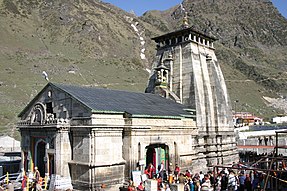 Kedarnath
Kedarnath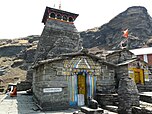 Tungnath
Tungnath Rudranath
Rudranath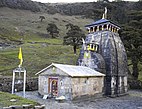 Madhyamaheshwar
Madhyamaheshwar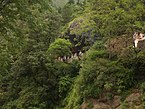 Kalpeshwar
Kalpeshwar
The presiding image of Kedarnath in the form of lingam is more triangular in shape with a pedestal 3.6 m (12 ft) in circumference and 3.6 m (12 ft) in height. There is a small pillared hall in front of the temple, that has images of Parvati and of the five Pandava princes. There are four temples around Kedarnath itself, namely- Tungnath, Rudranath, Madhyamaheshwar, and Kalpeshwar which form the Panch Kedar pilgrimage sites. The first hall inside Kedarnath Temple contains statues of the five Pandava brothers, Krishna, Nandi, the vehicle of Shiva and Virabhadra, one of the guards of Shiva. Statues of Draupadi and other deities are also installed in the main hall. An unusual feature of the temple is the head of a man carved in the triangular stone lingam. Such a head is seen carved in another temple nearby constructed on the site where the marriage of Shiva and Parvati was held. Behind the temple is the samādhi mandir of Adi Sankara.
Rituals
The head priest (Raval) of the Kedarnath temple belongs to the Veerashaiva community from Karnataka. However, unlike in Badrinath temple, the Raval of Kedarnath temple does not perform the pujas. The pujas are carried out by Raval's assistants on his instructions. The Raval moves with the deity to Ukhimath during the winter season. There are five main priests for the temple, and they become head priests for one year by rotation. The present (2013) Raval of Kedarnath temple is Shri Vageesha Lingacharya from Davanagere district, Karnataka. Surrounding Kedarnath, there are many symbols of the Pandavas. Raja Pandu died at Pandukeshwar. The tribals here perform a dance called "Pandav Lila". The mountain top where the Pandavas went to Swarga, is known as "Swargarohini", which is located off Badrinath. When Yudhishtira, the eldest of the Pandavas, was leaving for the heaven, one of his fingers fell on the earth. At that place, Yudhishtira installed a Shiva Linga, which is the size of the thumb. To gain Mashisharupa, Lord Shiva and Bheema fought with maces. Bheema was struck with remorse. He started to massage Shiva's body with ghee. In memory of this event, even today, this triangular Shiva lingam is massaged with ghee.
Administration
The temple was included in the Uttar Pradesh State Government Act No. 30/1948 as Act no. 16,1939, which came to be known as Shri Badarinath and Shri Kedarnath Mandir Act. The committee nominated by the state government administers both temples. The act was modified in 2002 by the Uttarakhand State Government, which provisioned adding additional committee members including government officials and a vice-chairman. There are a total of seventeen members in the board; three selected by the Uttarakhand Legislative Assembly, one member each selected by the District Councils of Chamoli, Pauri Garhwal, Tehri Garhwal and Uttarkashi districts, and ten members nominated by the Government of Uttarakhand. On the religious side, there is a Rawal (chief priest) and three other priests: Naib Rawal, Acharya/Dharmadhikari and Vedpathi. The administrative structure of the temple consists of a chief executive officer who executes the orders from the state government. A deputy chief executive officer, two OSDs, an executive officer, an account officer, a temple officer, and a publicity officer assist the chief executive officer.
2013 floods
Main article: 2013 North India floods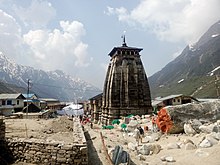
The Kedarnath valley, along with other parts of the state of Uttarakhand, was hit with unprecedented flash floods on 16 and 17 June 2013. On 16 June, at about 7:30 p.m. a landslide and mudslides occurred near Kedarnath Temple with loud peals of thunder. An enormously loud peal was heard and huge amounts of water started gushing from Chorabari Tal or Gandhi Tal down Mandakini river at about 8:30 p.m. washing everything away in its path. On 17 June 2013 at about 6:40 a.m. waters again started cascading at a huge speed from river Swaraswati and Chorabari Tal or Gandhi Tal bringing along with its flow huge amount of silt, rocks, and boulders. A huge rock got stuck behind Kedarnath Temple and protected it from the ravages of the flood. The waters gushed on both the sides of the temple destroying everything in their path. Even eyewitness observed that one large rock got carried to the rear side of Kedarnath Temple, thus causing obstruction to the debris, diverting the flow of river and debris to the sides of the temple avoiding damage. The rock which protected the temple is worshipped as the God's Rock (भीम शीला).
Another theory for the temple not being destroyed is because of its construction. Although the temple withstood the severity of the floods, the complex and surrounding area were destroyed, resulting in the death of hundreds of pilgrims and locals. Shops and hotels in Kedarnath were destroyed and all roads were broken. People took shelter inside the temple for several hours, until the Indian Army airlifted them to safer places. The Uttarakhand Chief Minister announced that the Kedarnath shrine would remain closed for a year for clearing the debris.

The experts, who were asked by the Archaeological Survey of India to examine the condition of the foundation in wake of the floods have arrived at the conclusion that there was no danger to the temple. The IIT Madras experts visited the temple thrice for the purpose. Non-destructive testing instruments that do not disturb the structure of the temple were used by the IIT-team for assessing the health of the structure, foundation, and walls. They have submitted their interim report that the temple is stable and there was no major danger.
Nehru Institute of Mountaineering (NIM) was given the responsibility of rebuilding Kedarnath. Although the institute did not have the expertise in urban planning or construction, they mastered in high altitude training. Under the leadership of veteran mountaineer, Colonel Ajay Kothiyal, NIM rigorously worked for a year and made the pilgrimage yatra possible from the next year.
See also
- Adi Shankara
- Gangotri Temple
- Gaurikund
- Jyotirlinga
- Yamunotri Temple
- Chota Char Dham
- Panch Kedar
- Jageshwar
References
- ^ James G. Lochtefeld (2002). The Illustrated Encyclopedia of Hinduism: A-M. Rosen. pp. 363–364. ISBN 978-0-8239-3179-8.
- ^ "Kedarnath Temple". Kedarnath - The official website. 2006. Retrieved 16 May 2021.
- J. Gordon Melton; Martin Baumann, eds. (2010). Religions of the World: A Comprehensive Encyclopedia of Beliefs and Practices. Vol. 1 (A-B) (2nd ed.). ABC-CLIO. p. 1624. ISBN 978-1-59884-204-3.
- "KEDARNATH". chardhamtour.
- "Tiruketharam (Kedarnath)" (in Tamil). Archived from the original on 6 November 2021. Retrieved 6 November 2021.
- Joanna Sugden; Shreya Shah (19 June 2013). "Kedarnath Temple Survives Flash Floods". WSJ.
- Abram, David (2003). The Rough guide to India. New York: Rough Guides.
- ^ Diana L. Eck (2013). Banaras: City of Light. Knopf Doubleday. pp. 185–186. ISBN 978-0-307-83295-5.
- ^ "Panch Kedar Yatra". Retrieved 5 July 2009.
- Kapoor. A. K.; Satwanti Kapoor (1994). Ecology and man in the Himalayas. M.D. Publications Pvt. Ltd. p. 250. ISBN 9788185880167.
- "Panch Kedar". chardhamtour.in. 5 March 2014. Retrieved 4 March 2022.
- "Panch Kedar". Archived from the original on 31 August 2009. Retrieved 15 July 2009.
- ^ Alex McKay (2015). Kailas Histories: Renunciate Traditions and the Construction of Himalayan Sacred Geography. Brill. p. 135. ISBN 978-90-04-30618-9.
- ^ N. V. Isaeva (1993). Shankara and Indian Philosophy. SUNY Press. pp. 90–91. ISBN 978-0-7914-1282-4.
- Edward Quinn (2014). Critical Companion to George Orwell. Infobase. p. 232. ISBN 978-1-4381-0873-5.
- Jean M. Grove (2004). Little Ice Ages: Ancient and Modern. Taylor & Francis. p. 238. ISBN 978-0-415-33422-8.
- ^ "Kedarnath Temple: Interesting Facts About The Significant Lord Shiva Temple That Will Leave You Surprised". English Jagran. 20 December 2023. Retrieved 31 January 2024.
- Harshananda, Swami (2012). Hindu Pilgrim centres (2nd ed.). Bangalore, India: Ramakrishna Math. pp. 71–3. ISBN 978-81-7907-053-6.
- Whitmore, Luke (2018). Mountain, Water, Rock, God: Understanding Kedarnath in the twenty-first century. University of California Press. p. 38.
- "Uttarakhand government website". Government of Uttarakhand. Archived from the original on 10 June 2008. Retrieved 9 September 2013.
- ^ "Kedarnath priest's family prays for his safe return". Deccan Herald. 24 June 2013. Retrieved 9 September 2013.
- "Garhwali Dance Forms". euttaranchal.com. 6 March 2013.
- "Administration of the temple". Shri Badrinath - Shri Kedarnath Temples Committee. 2006.
- "Committee members of the temple". Shri Badrinath - Shri Kedarnath Temples Committee. 2006.
- "Religious setup of the temple". Shri Badrinath - Shri Kedarnath Temples Committee. 2006.
- "Power structure of the temple". Shri Badrinath - Shri Kedarnath Temples Committee. 2006. Retrieved 9 September 2013.
- "What happened on the night of 16th June inside Kedarnath temple". Tehelka.com. 17 June 2013. Archived from the original on 29 October 2013. Retrieved 9 September 2013.
- "Account of survivors of Uttarakhand floods". Yahoo newsuutar. 17 June 2013. Retrieved 9 September 2013.
- "Account of survivors". youtube.com. 17 June 2013. Archived from the original on 31 October 2021. Retrieved 9 September 2013.
- "Account of flood victims". youtube.com. 17 June 2013. Archived from the original on 31 October 2021. Retrieved 9 September 2013.
- "Monsoon fury leaves Kedarnath shrine submerged in mud and slush". The Indian Express. 19 June 2013. Retrieved 9 September 2013.
- "Kedarnath shrine safe, to remain closed for a year". The Hindu. 19 June 2013. Retrieved 9 September 2013.
- "In Rebuilding Kedarnath, a New Disaster in the Making". The Wire. Retrieved 1 June 2019.
Further reading
- Chaturvedi, B. K. (2006). Shiv Purana (First ed.). New Delhi: Diamond Pocket Books (P) Ltd. ISBN 81-7182-721-7.
- Eck, Diana L. (1999). Banaras, city of light (First ed.). New York: Columbia University Press. ISBN 0-231-11447-8.
- Gwynne, Paul (2009). World Religions in Practice: A Comparative Introduction. Oxford: Blackwell Publication. ISBN 978-1-4051-6702-4.
- Harding, Elizabeth U. (1998). "God, the Father". Kali: The Black Goddess of Dakshineswar. Motilal Banarsidass. pp. 156–157. ISBN 978-81-208-1450-9.
- Lochtefeld, James G. (2002). The Illustrated Encyclopedia of Hinduism: A-M. Rosen Publishing Group. p. 122. ISBN 0-8239-3179-X.
- R., Venugopalam (2003). Meditation: Any Time Any Where (First ed.). Delhi: B. Jain Publishers (P) Ltd. ISBN 81-8056-373-1.
- Vivekananda, Swami. "The Paris Congress of the History of Religions". The Complete Works of Swami Vivekananda. Vol. 4.
External links
| Hindu temples in Uttarakhand | |
|---|---|
| Almora | |
| Bageshwar | |
| Chamoli | |
| Champawat | |
| Dehradun | |
| Haridwar | |
| Nainital | |
| Pauri Garhwal | |
| Pithoragarh | |
| Rudraprayag | |
| Tehri Garhwal | |
| Udham Singh Nagar | |
| Uttarkashi | |
| Shaivism | |||||||||||
|---|---|---|---|---|---|---|---|---|---|---|---|
| History | |||||||||||
| Deities |  | ||||||||||
| Texts | |||||||||||
| Mantra/Stotra | |||||||||||
| Traditions | |||||||||||
| Festivals and observances | |||||||||||
| Shiva temples |
| ||||||||||
| Related topics | |||||||||||
| State of Uttarakhand | |||||||||||||||||||
|---|---|---|---|---|---|---|---|---|---|---|---|---|---|---|---|---|---|---|---|
| State capitals: legislative: Dehradun (winter); Bhararisain (summer); judicial: Nainital | |||||||||||||||||||
| Government |
| ||||||||||||||||||
| History |
| ||||||||||||||||||
| Geography and ecology |
| ||||||||||||||||||
| Demographics |
| ||||||||||||||||||
| Administrative divisions |
| ||||||||||||||||||
| Politics | |||||||||||||||||||
| Tourism |
| ||||||||||||||||||
| Sports | |||||||||||||||||||
| Other topics | |||||||||||||||||||
| Districts |
| ||||||||||||||||||
| Major cities | |||||||||||||||||||